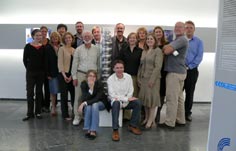
Handy Links
SLAC News Center
SLAC Today
- Subscribe
- Archives: Feb 2006-May 20, 2011
- Archives: May 23, 2011 and later
- Submit Feedback or Story Ideas
- About SLAC Today
SLAC News
Lab News
- Interactions
- Lightsources.org
- ILC NewsLine
- Int'l Science Grid This Week
- Fermilab Today
- Berkeley Lab News
- @brookhaven TODAY
- DOE Pulse
- CERN Courier
- DESY inForm
- US / LHC
SLAC Links
- Emergency
- Safety
- Policy Repository
- Site Entry Form

- Site Maps
- M & O Review
- Computing Status & Calendar
- SLAC Colloquium
- SLACspeak
- SLACspace
- SLAC Logo
- Café Menu
- Flea Market
- Web E-mail
- Marguerite Shuttle
- Discount Commuter Passes
-
Award Reporting Form
- SPIRES
- SciDoc
- Activity Groups
- Library
Stanford
Around the Bay
Particle Physics and the Press
 The media have a central role in telling the story of research in particle physics. We need to put aside our differences and keep our eyes on the big picture if we are to make the most of this vast resource, say members of the InterAction collaboration.
The media have a central role in telling the story of research in particle physics. We need to put aside our differences and keep our eyes on the big picture if we are to make the most of this vast resource, say members of the InterAction collaboration.
These are exciting times for particle physics, and the world's press are taking notice. As the Large Hadron Collider prepares to begin operations, as the International Linear Collider becomes an ever more clearly defined project, as programs for neutrino physics and astrophysics flourish, and most of all as long-awaited discoveries reveal the secrets of the universe, our friends in the media will share the adventure. Their stories and articles, TV programs, blogs and podcasts will inform and inspire others with the spirit of excitement that particle physicists are feeling at the start of the 21st century.
The journalists who tell our story will have wildly varying backgrounds, skills and points of view. Their pieces will cover the spectrum of science journalism. They will define and describe; compare and contrast; make judgments and express opinions; and praise and criticize. Writing in language that is accessible to their readers, they will at times seem wanting in their grasp of scientific subtleties. Sometimes they will appear to lack appreciation for something that we care deeply about; occasionally they may even give more credit than we deserve.
It is accepted wisdom that the press almost always get it wrong. Actually, in our experience, ultimately they get it just about right. In the months and years ahead, the majority of journalists who tell the story of 21st-century particle physics will do an excellent job. From time to time, inevitably, they will get it wrong—at least as we see it. A true test of our character as a field is how we react to this level of media coverage.
At a time of extraordinary scientific opportunity in particle physics, we must keep our eyes on the science and enjoy the privilege of taking part in discovering how the universe works. We should equally enjoy the opportunity afforded by the media's interest.
In the past, there have been occasions when our field has devolved into warring camps, reading each new press article with suspicion, quick to take offence at every real or imagined slight or bias. It's time to change this model. Do we want to be seen as a fractious, contentious community beset by invidiousness, or as a unified community of committed scientists confronting a golden age of discovery? We have the choice. We can set a tone of respect and admiration for all projects and experiments that lead to discovery—or one that begrudges every word of praise for others' work. Without fail, the media will pick up on our tone. So will our colleagues, our students, scientists in other disciplines and we ourselves. It will be part of what defines the kind of field that we are.
Competition will always exist, and this is a good thing. People care passionately about their work. Of course they want to see it recognized, and defend it if it is unfairly criticized. But we have everything to gain by maintaining perspective. There will be hundreds of stories during the years ahead. Today's lukewarm review will be tomorrow's encomium – and vice versa. We should take them all in our stride, because we are in this together for the long haul. We all want to discover how the universe works. It's a big universe with room, and credit, enough for everyone.
This article is being published simultaneously in the October issues of CERN Courier and symmetry. Members of InterAction, a collaboration of particle-physics communicators from laboratories around the world (www.interactions.org): Roberta Antolini, INFN Gran Sasso; Peter Barratt, PPARC; Natalie Bealing, CCLRC/RAL; Stefano Bianco, INFN Frascati; Karsten Buesser, DESY; Neil Calder, SLAC; Elizabeth Clements, ILC; Reid Edwards, Lawrence Berkeley National Laboratory; Suraiya Farukhi, Argonne National Laboratory; James Gillies, CERN; Judith Jackson, Fermilab; Marge Lynch, Brookhaven National Laboratory; Youhei Morita, KEK, ILC; Christian Mrotzek, DESY; Perrine Royole-Degieux, IN2P3, ILC; Yves Sacquin, DAPNIA CEA; Ahren Sadoff, Cornell University LEPP; Maury Tigner, Cornell University LEPP; and Barbara Warmbein, ILC.
—The InterAction Collaboration
SLAC Today, October 10, 2006
Above image: The InterAction Collaboration of particle-physics communicators in Hamburg, Germany, in October 2006. (Image courtesy KEK. Click image for larger version.)